31st Xerox Users Exchange Proceedings, San Francisco, October 1979, pg. 231-247
Improving COBOL Performance
for
Improving COBOL Performance
George Plue is Systems Programming Manager and Computer
Hardware Maintenance Supervisor for Andrews University
Computing Center. George has held these positions for
six years. George was the principle designer for the
enhancements described in this paper. Dan Bidwell has
been a Systems Programmer at AUCC for three years and
did much of the implementation of the projects
described. Keith Calkins has been a Systems Programmer
for about a year. He did much of the writing of this
paper, some of the implementation and now holds the bag
for making it all work.
Improving COBOL Performance
AUTHOR:
Daniel R. Bidwell,
Keith G. Calkins, and
George S. Plue
ABSTRACT:
This paper describes two enhancements for systems using
COBOL. The first is a shared public library containing
most of the run-time subroutines required by a COBOL
object program, as well as the most commonly used
subroutines at Andrews University. The second
enhancement is a processor which splits a COBOL object
program into separate data and procedure control
sections. These changes greatly reduce swapping during
execution of COBOL programs, especially in an online
environment. The shared library has been in use since
February 1978, and the processor was installed in
September 1978. This software will be available
through the user's group library.
Andrews University in
Berrien Springs, Michigan is
a private educational institution composed of four
schools with approximately 3,500 students. About
two-thirds of our computing effort is development and
execution of COBOL programs in support of our
administrative work. The other one-third is a broad
mix of work in other languages in support of academic
effort. We must be on guard, especially during our
online registrations, to maintain acceptable response
and throughput on our
Xerox Sigma 6 Computer with 128K
[words, each 4 bytes] of core memory and a 7232 RAD
[a 6.3Mb fixed head disk or Rapid Access Device].
Before introducing the changes described in this
paper all COBOL programs were treated as data, that is
the procedure and data were in the same control section
(00, read and write access) (Figure 1). The COBOL
run-time library, consisting of I/O routines, numeric
conversion routines, etc., was also treated as data.
Every COBOL program required its own copy of any
run-time routines which were used.
In an interative timesharing environment the user
requesting service is likely to be on the swapping
device rather than in main memory. Before this user
can be serviced sufficient space must be available in
main memory for inswap. This is usually accomplished
by the outswap of another user (or users). (Ideally
the scheduler is able to keep the CPU busy during this
transition.) Pure procedure is not swapped out because
the copy on the swapping device is identical to the
copy in main memory.
Pure procedure, because it is never modified,
can also be shared among several users via the hardware
memory map. This represents a significant reduction in
total core usage.
For these reasons a COBOL shared library and a
COBOL compiler post-processor (XROM), which separates
the data from procedure in COBOL ROM's, were developed.
In addition this permits programs written in COBOL to
be used as shared processors.
The idea for the COBOL shared library came from the
FORTRAN shared library, which also supplied many of the
design concepts.
The library is divided into two parts to allow for
dynamic replacement of library routines without
reloading all programs that use it. The first part,
the Branch Vector, is the absolute interface between
the user programs and the library routines which
comprise the second part. This allows the actual
library routines to vary in size while the definitions
of the routines remain at an absolute address. Thus
the order of the Branch Vector, once established, may
not be altered (without reloading all associated
programs). It can however be lengthened.
Several standard COBOL run-time library routines
were not included in the package because of their low
usage at our installation. These include: Debugger
(DBGR,TRC), Exponentiation (EXP), No Co-Resident Sort
(NCRS), Report generator (RRG), FORMESS, GETCOM, and
SETZERO. In addition, numerous commonly used local
routines have been included in the library because of
their high usage. Our shared library with local
application routines occupies thirteen pages, but
without our routines the total size is only nine pages.
The library has been in use since February 1978.
One of the major problems encountered while creating
the COBOL shared library was that the original
COBOL run-time library was not designed to be used as a
shared library. There is no practical way to
pre-initialize the library context area so this must be
done at run time by an initialization routine in the
library. Since there is no subroutine that is always
called as the first thing in the program the
initialization routine must be called by all of the
programs that use the initialized area. We have used
the library error stack in the TCB to flag completed
initialization (Figure 2). The shared library does not
use the library error stack so during initialization it
modifies the stack pointer doubleword to say there
is one entry on the stack.
Another problem with a shared library is that some
of the routines reference items that are DEF'ed by the
loader or the COBOL compiler in the user program. An
example of this is the data references required by the
inspect and the trap routines. The addresses were
obtained by separating the routine into a shared and a
non-shared portion. The non-shared portion is loaded
with the user program and can thus obtain and pass the
needed addresses to the shared portion of the routine.
Another example is that the I/O routines need to know
the address of M:DO to output error messages. We
solved this by writing a subroutine that finds the
address of M:DO by looking it up in the DCB name table.
One of the design limitations in the old run-time
library is that the routine that does all the I/O
processing modifies the FPT's to fit the current I/O
operation. This is no longer allowed because the FPT's
are all in the write protected area. The shared
library I/O routines now have a table of valid FPT's
for the available I/O operations. So instead of
modifying an existing FPT it calculates an index to
point to the appropriate FPT in the table. This method
is faster than the old one. This technique does not
work for some applications, and is [sic s/b in] cases the
existing skeleton FPT must be moved to the
context area because they are updated. This only
occurs after an irrecoverable error.
When introducing write protection for pure
procedure areas a problem with standard COBOL emerged.
If a packed decimal variable was compared to a literal
space (X'40') the standard processor trapped and the
trap handler modified the literal and retried the
compare. Since literals are write protected alteration
is no longer permitted and the trap handler logic had
to be revised.
With the onset of pure procedure COBOL programs we
had to change the I/O error routine to give the proper
relative addresses for both the old and new programs.
We found it essential to change the COBOL compiler such
that the PMAP always starts at zero. This altered
slightly the way in which applications programmers used
the PMAP. It should also be noted that, because of
problems like the one mentioned above in the trap
routine, pure procedure programs must use the shared
library.
A notable amount of library data area was saved by
using much of the library context area as a scratch
area. The context area is only as large as the data
area for the largest routine (and the routines that it
references). The data savings amount to about 0.52K
words per user.
Of the 6,362 lines of library source code, more
than 20% was changed and about 10% was added. See
example in Figure 3.
A thorough understanding of Xerox Standard
Relocatale Object (ROM) Language is necessary for a
detailed description of how XROM works. The function
of XROM is to separate the procedure from the data in a
given COBOL-produced Relocatable Object Module (ROM),
changing the access-protection code of the procedure to
01 (write protect). This process was included in the
design phase of the COBOL compiler but was not carried
through implementation.
The implementation of XROM presents little change
for the COBOL programmer. The altered PMAP is now
added to the start address rather than the beginning
data address. We patched the COBOL compiler to
automatically transfer control to XROM at the
completion of the compile unless the user specifically
asked for the NMP (No Memory Protection) option. (We
disabled the SEQCHK (sequence check) option to allow
our NMP option.)
The prototype for XROM was finished in September
1978 and the XROM processor was completed in November
1978. In April 1979, after five months of error-free
testing, the patches were installed in the COBOL
compiler to make it our system default.
The prototype for XROM took about two man-months to
complete after we had attained a thorough working
knowledge of the library routines and COBOL program
structure. After a short investigation it was found
that COBOL programs do not modify their own code with
the PERFORM and ALTER statements. With this knowledge
we started enthusiastically analyzing LO listings of
small COBOL programs to find out how to split the data
and procedure apart. A program was written to strip
the LO listing of extraneous garbage to prepare the
file for assembly. This included rebuilding all of the
DCB's because the COBOL LO included only a skeleton of
the DCB.
One major problem with the COBOL LO was its
inconsistency from one program to another. After an
extensive search for additional rules to follow we had
three versions of the prototype that were used to
convert our first six programs. The only way to tell
which version to use was to try one and if it did not
work properly to try another version. Some of the
symptoms include getting memory protection traps, the
character 9 (X'F9') not being numeric, all the display
literals being off by one byte, or the numeric edited
fields being off.
Once the COBOL LO was converted into an assembly
source, it was then ready for AP. This whole process
took about two and a half times that of a normal
compile! The first COBOL shared processor was produced
by the prototype in this manner. The prototype was not
a practical means of separating the data and procedure
on a daily basis, but the production version could not
have been written without first having used the
prototype to define the rules for the conversion.
The XROM processor makes two passes of the ROM and
evaluates each expression up to six times as it
generates its tables and output expressions and code.
XROM converts all ROM's produced by the COBOL compiler
(GO, BO, and overlays). The XROM transformation adds
5% to 10% to the total compile execution time.
These two enhancements have brought about the
following noticeable effects:
- The shared library reduces the average user
program size by three to eight pages. This
makes it possible to have more concurrent
users in main memory (Figure 4). Since most
of the run-time routines are in the shared
library several users are required to save the
thirteen pages and justify the shared library.
- Because of its frequent use, the shared
library is almost always in main memory. This
combined with pure procedure load modules
results in up to 40% swap reduction (Figure 5).
Total swap = inswap + outswap
inswap = DCB's + data + other + procedure
outswap = DCB's + data + other [other includes JIT, AJIT, SBUF1, SBUF2]
Also used in this calcuation was the fact
that the programs using the shared library are smaller.
- Multi-user programs written in COBOL can be
used as shared processors. (Figure 6) Even for
a small number of users a significant savings
in core requirements can be realized.
- Previously unresolved problems in user
programs such as indexing out of range are now
often obvious because of the write protect
access of the procedure.
- A substantial savings of public disk space was
realized due to the smaller program size.
Given that 850 of our 1350 (63%) disk resident
COBOL programs use the shared library and an
average of 5 granules is saved per load
module, we have already gained about 4000
granules of public disk space!
| |
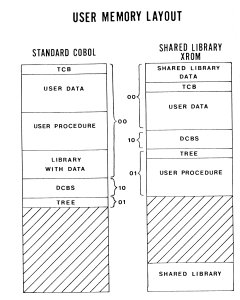
| | |
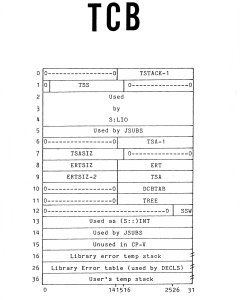
| | |
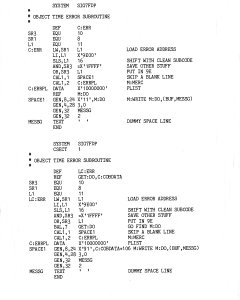
|
| | Figure 1
| | | Figure 2
| | | Figure 3
|
|
|
| |
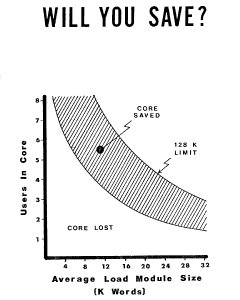
| | | `
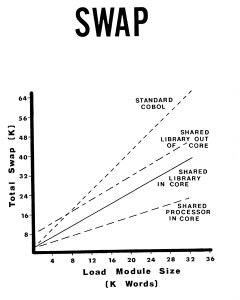
| | |
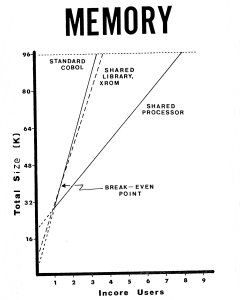
|
| | Figure 4
| | | Figure 5
| | | Figure 6
|
The basic division of labor on this paper was
Dan did the work, Keith wrote the paper, and George did the figures.
Keith was to present it also, but that was not to be.
George and Dan flew out in George's plane the prior weekend.
One hour before Keith was to leave for the airport on Wednesday,
the computer system went down and stayed down for almost a week.
Those details need to be written up, but links to these pictures
will have to suffice for now.
The $50 honorarium was divided VERY evenly, however.
| |
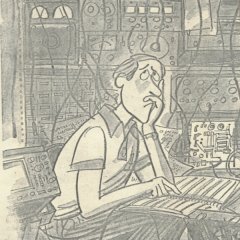
| | |
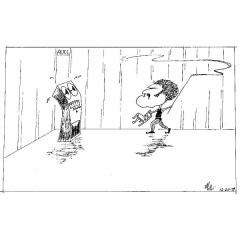
|
| | KGC's nightmare
| | | GSP, the Sigma tamer
|







